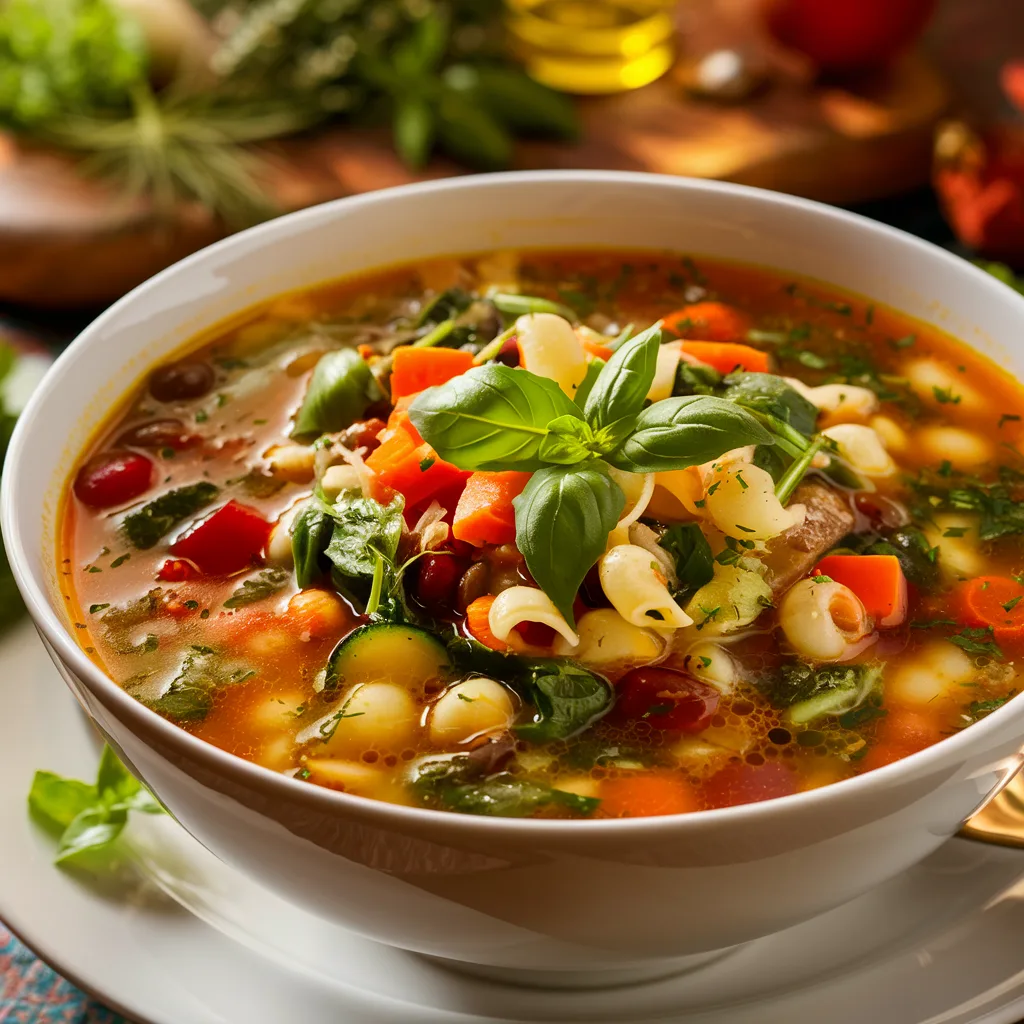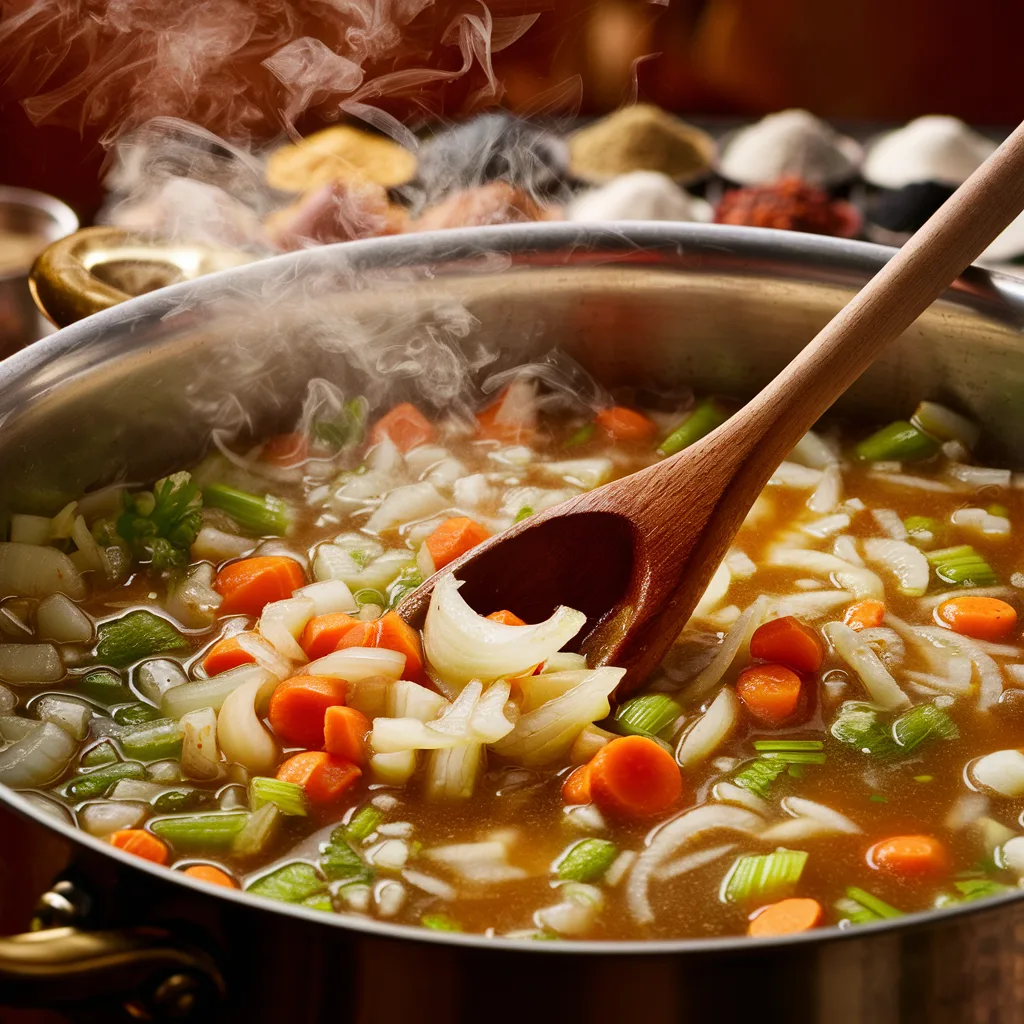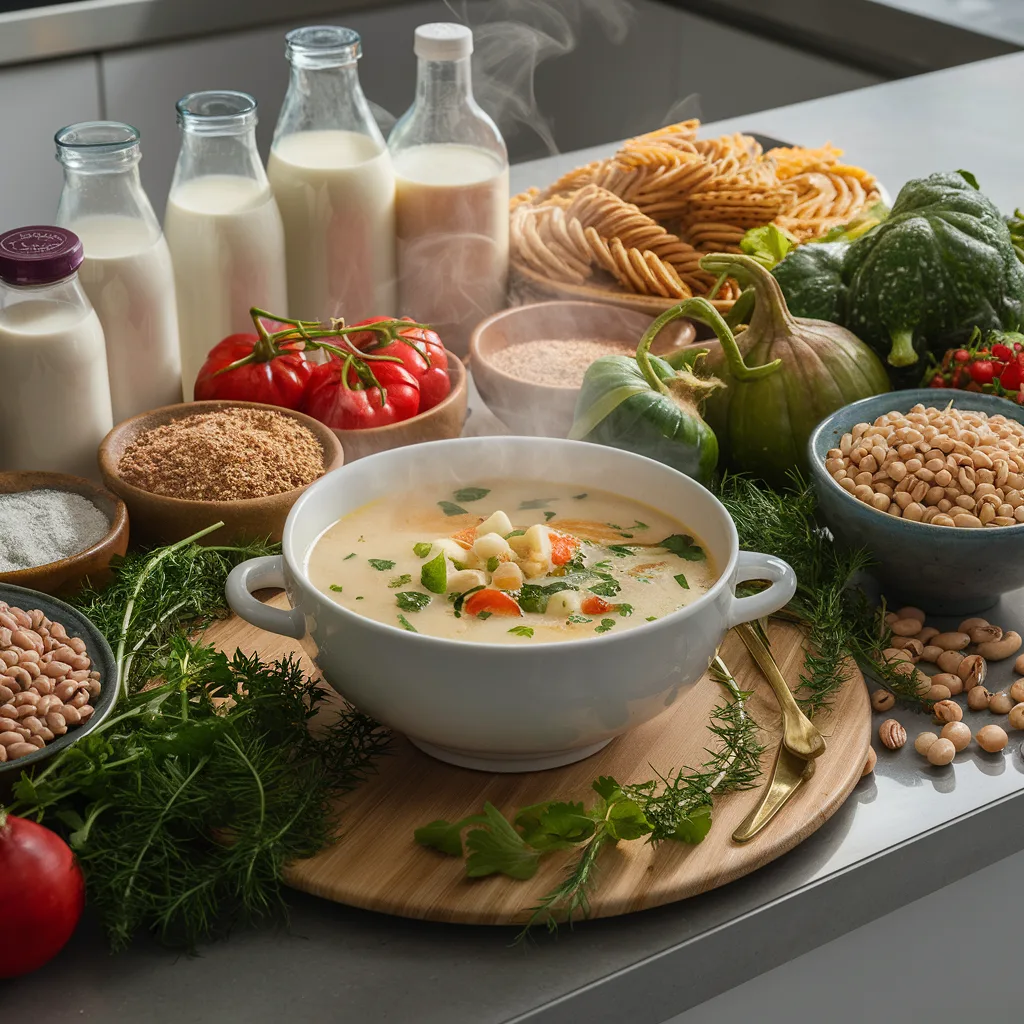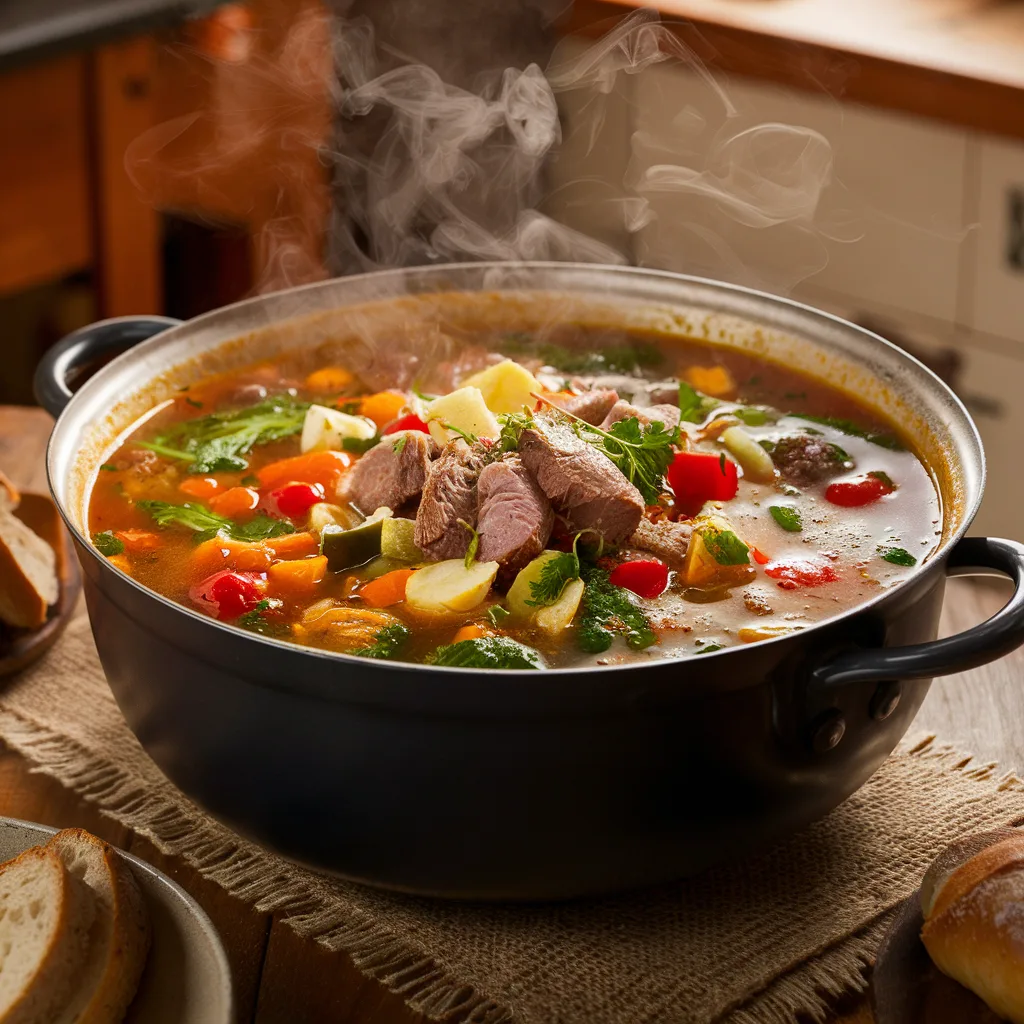As the air gets crisp and days get shorter, nothing beats a warm pot of homemade soup. The smell of cooking, the sound of bubbles, and that first sip bring joy. These five pot of soups are perfect for any gathering or to feed your family.
Key Takeaways
- Five top-rated, hearty soup recipes perfect for feeding a crowd
- Recipes include classic chicken noodle, vegetable minestrone, and creamy butternut squash
- Soups offer comfort, warmth, and nourishment for gatherings or everyday meals
- Many recipes can be prepared in large batches and frozen for convenience
- Variety of options, including vegetarian and meat-based soups, to suit diverse preferences
Understanding the Appeal of Large-Batch Soup Making
Cooking soup in large quantities has many benefits. It’s great for busy households and gatherings. It saves money and time, making it a smart choice.
Benefits of Cooking Soup in Large Quantities
One big plus is saving money. Buying ingredients in bulk and making a lot of soup can cut costs. This way, you can enjoy homemade soup without spending too much.
It also saves time. Making a big batch of soup one afternoon can save you a lot of time during the week. Many recipes can be ready in 35 minutes or less. Using a slow cooker makes it even easier, letting you just set it and forget it.
Essential Equipment for Big-Batch Soup Preparation
Having the right tools is key for making large batches of soup. You’ll need a big soup pot and a sturdy ladle. Also, good storage containers are important to keep the soup fresh when you freeze it.
Time and Cost-Saving Advantages
Large-batch soup making saves you time and money. It lets you have ready-to-eat portions even when you’re very busy. You can also freeze it for up to three months, always having a meal ready.
“Cooking soup in large quantities allows me to dedicate an afternoon to the process, ensuring I have a variety of hearty, comforting soup recipes on hand for the whole week.”
Classic Chicken Noodle Soup for a Gathering
Chicken noodle soup is a favorite for feeding many. It’s made with a mix of chicken parts for a rich homemade broth. This chicken soup also includes tender egg noodles, fresh carrots, celery, and onions. It’s quick to make, perfect for busy times or sudden gatherings.
Using different chicken parts, like rotisserie chicken and thighs, makes the broth rich and flavorful. Onions, celery, and garlic add to the savory taste. A bit of dried herbs like basil and oregano add a nice touch.
This chicken noodle soup takes about 40 minutes to prepare. It’s great for a quick meal. You can keep leftovers in the fridge for 3 to 4 days or freeze them for up to 6 months.
To make your chicken noodle soup even better, try it with warm biscuits, grilled cheese, or a French baguette. There are many ways to enjoy this classic comfort food.
| Ingredient | Quantity |
|---|---|
| Chicken (rotisserie, breasts, thighs) | Varies |
| Carrots, peeled and sliced | 3 cups |
| Celery, sliced | 2 cups |
| Onion, diced | 1 cup |
| Egg noodles, uncooked | 2 cups |
| Chicken broth | 8 cups |
| Dried basil | 1 teaspoon |
| Dried oregano | 1/2 teaspoon |
| Salt and pepper | To taste |

Hearty Vegetable Minestrone with Italian Herbs
Get ready to enjoy a comforting vegetable minestrone soup. This Italian dish is loved by many, filled with seasonal veggies, pasta, and beans. The secret is the Italian herbs that make every sip taste like the Mediterranean.
Selecting Fresh Seasonal Vegetables
This minestrone soup is great because it uses what’s in season. Use fresh veggies like:
- Carrots
- Zucchini
- Spinach
- Tomatoes
- Onions
- Celery
Pasta and Bean Combinations
Make your minestrone even better with pasta and beans. Use small pasta like elbow macaroni or ditalini. Add beans like cannellini, kidney, or garbanzo for more protein and fiber.
Herb and Seasoning Guidelines
The key to a real Italian minestrone is the herbs and seasonings. Use fresh or dried herbs like basil, oregano, and thyme. Add salt and pepper to taste for a richer flavor.
“This minestrone soup is an absolute delight! The combination of fresh vegetables, pasta, and beans creates a hearty and satisfying meal that’s perfect for a crowd. The Italian herbs take it to the next level, providing a depth of flavor that’s simply irresistible.”
Creamy Butternut Squash Soup with Coconut
As the air gets cooler and leaves change, nothing is as comforting as a warm butternut squash soup. This vegan recipe mixes butternut squash’s sweetness with coconut milk‘s creaminess. It makes a delicious and creamy soup great for sharing.
This vegan soup is quick to prepare, with only 15 minutes needed for prep. It cooks in 45 minutes, making it a cozy autumn meal. Its bright orange color and spicy aroma make it a hit at any Fall event or Thanksgiving.
| Yield | Prep Time | Cook Time | Total Time |
|---|---|---|---|
| 6 servings | 15 minutes | 45 minutes | 1 hour |
To make this creamy butternut squash soup, you need a few simple ingredients:
- 1 tbsp Unsalted butter (or olive oil for dairy-free)
- 3 cloves Garlic, sliced thinly
- 1 large Carrot, sliced (optional)
- 3 lb Butternut squash, peeled and cut into 1-inch cubes
- 2 cups Chicken broth, reduced sodium (or vegetable broth for vegetarian)
- 1/2 tbsp Sea salt
- 1/4 tsp Black pepper
- 1/2 cup Full-fat coconut milk (or heavy cream)
To get a smooth texture, sauté the garlic and aromatics first. Then add the squash and broth. Blend until creamy, then add the coconut milk for extra richness.
This butternut squash soup is not just tasty but also healthy. It has 194 calories, 29g of carbs, and 5g of fiber per serving. It’s filling and perfect for meal prep and reheating. Plus, it freezes well, so you can enjoy it all season.

Pot of Soup Fundamentals: Building Flavors
Making a delicious homemade soup is an art. It starts with learning the basics. The secret to a rich flavor is knowing your base ingredients and how to layer them.
Base Ingredients and Aromatics
A great soup begins with a solid base. Start by cooking onions, carrots, and celery in soup base. This step unlocks their natural sweetness and deepens the taste, setting the stage for the rest.
Adding bone broth or quality store-bought stock boosts the flavor. Bone broth adds a smooth texture and a touch of umami to your soup.
Layering Techniques for Deep Flavor
- Add ingredients gradually, letting each one add its own flavor and blend well.
- Try different soup seasonings like herbs, spices, and acids for a rich taste.
- Simmer the soup gently to let the flavors mix slowly and evenly.
- Season the soup just before it’s done to get the perfect balance of salt, acidity, and sweetness.
Learning to build a flavorful soup base and layering ingredients carefully will make your soups unforgettable. Be patient and pay attention to detail. You’ll get a soup that warms your heart and pleases your taste buds.
Rich and Warming Beef and Bean Soup
Enjoy the cozy warmth of a beef soup filled with bean soup goodness. It’s a perfect choice for a cold day with friends and family. The mix of tender beef and beans makes a protein-rich, hearty stew that everyone will love.
The soup’s rich taste comes from its layered flavors. First, the beef is seared to keep its juices and get a tasty crust. Next, vegetables and aromatics are cooked, setting the base for the broth. Finally, beans, spices, and herbs simmer, blending their flavors.
To make this comforting beef soup, you’ll need:
- Beef broth
- Diced potatoes
- Frozen mixed vegetables
- Canned diced tomatoes
- Stew meat (or ground beef)
- Butter
- Worcestershire sauce
- Onion
- Bay leaves
- Salt and pepper
The cooking process is simple: sear the meat, add veggies and seasonings, then simmer until the meat is tender. You can also make it in a Dutch oven, crockpot, or Instant Pot for different cooking options.
This hearty stew is perfect for any gathering or a cozy evening. Feel free to add your favorite beans, herbs, and spices to make it your own. It’s a slow-cooked meal that will warm your heart.
Time-Saving Tips for Large Soup Preparations
Preparing hearty soups in large batches can change your weekly meal routine. To make it easier and faster, try these tips for your soup prep.
Prep Work Strategies
Chopping veggies ahead of time is a big time-saver. Use a food processor to quickly chop onions, carrots, and celery. Also, prep your proteins like chicken or beef by cooking and cutting them early.
Storage Solutions
Storing soup properly is key for large batches. Divide the soup into containers that can go in the freezer. This makes reheating easy and avoids thawing a whole batch. Label the containers with the soup type and date for easy finding.
Using these strategies can cut down the time and effort needed for big soup batches. You’ll have a tasty, homemade soup ready whenever you want, without the stress of starting over.
“Meal prep is a game-changer when it comes to saving time and ensuring a healthy, home-cooked meal is always within reach.”
Proper Storage and Freezing Methods
Keeping your homemade soups fresh and flavorful is important. The right storage methods can make your soups last longer. This way, you can enjoy them for weeks or even months.
First, cool the soup quickly before putting it in the fridge or freezer. This step is crucial to keep the soup’s quality and prevent bacteria. Use airtight containers or freezer bags, leaving space for the soup to expand when it freezes.
It’s also key to label the containers with what’s inside and when you made it. Most soups can stay frozen for up to three months. This makes it easy to have ready-to-eat meals later. To thaw, let it slowly thaw in the fridge overnight to keep the soup’s texture.
Reheating frozen soup is easy. Just warm it on the stovetop or in the microwave. Start with medium heat or 50% power for about 8 minutes, checking until it’s hot enough.
With these easy steps, you can enjoy your homemade soups for a long time. This makes meal planning simple and helps reduce food waste.
Freezer-Friendly Soup Containers
| Container Type | Capacity |
|---|---|
| Souper Cubes | 2-cup and 1-cup sizes |
| Freezer-safe Food Containers | 32-ounce and 16-ounce |
| Gladware Freezerware Containers | 64-ounce |
| Straight-sided Jars | Leaving 1-inch headroom |
By following these tips for soup storage and freezing, you can save money and time. Enjoy your leftover soup for weeks with these easy meal planning tips.
Garnishing and Serving Suggestions
Make your hearty soups stand out with creative garnishes and side dishes. These touches can make your soup a hit with everyone.
Complementary Side Dishes
Try these side options with your flavorful soups:
- Crusty bread or rolls for dipping and sopping up every last drop
- A light, fresh salad with a simple vinaigrette to balance the richness of the soup
- Roasted vegetables like Brussels sprouts, carrots, or cauliflower to add color and texture
- Creamy mashed potatoes or buttery pasta to create a heartier, more substantial meal
Presentation Tips for Large Groups
For a crowd, set up a “soup bar” where guests can customize their bowls. Offer a variety of garnishes and toppings, such as:
- Freshly chopped herbs like parsley, chives, or thyme
- Crispy croutons, crushed tortilla chips, or shredded cheese
- A dollop of sour cream, crème fraîche, or grated Parmesan
- Sliced avocado, diced tomatoes, or chopped scallions
Serve the soup in attractive, heat-safe bowls or mugs. Make sure you have the right utensils for easy self-service. This interactive approach lets guests make their soup their own, adding fun to the meal.
The secret to great soup serving is finding the right mix of flavor, presentation, and convenience. By offering a range of garnishes and side dishes, you can turn your soup into a memorable and satisfying meal.

Dietary Modifications and Substitutions
When making soups for a crowd, it’s key to meet different dietary needs. You can easily adjust your favorite soup recipes for vegetarians, vegans, or those with gluten sensitivities.
For vegetarian options, choose vegetarian soup or vegan soup instead of meat-based broths. Use plant-based proteins like beans, lentils, or tofu for heartiness. Try seasonal gluten-free soup ingredients like quinoa, rice, or gluten-free pasta for those with dietary restrictions.
- Use vegetable broth instead of chicken or beef broth for vegetarian soup and vegan soup options.
- Substitute dairy with plant-based milk, yogurt, or cheese for dairy-free and vegan soup versions.
- Choose gluten-free grains, pasta, or thickeners to make gluten-free soup recipes.
By offering soups that fit various diets, everyone at your gathering can enjoy a comforting meal. A bit of creativity can help you meet many dietary restrictions and preferences.
“The Dietary Guidelines recommend limiting foods and beverages high in added sugars, saturated fat, and sodium.”
Adjusting soups for different diets doesn’t mean they can’t be tasty. With some planning and trying new things, you can make dishes that please everyone.
Conclusion
Homemade soup has a special power to bring people together. It offers comfort and nourishment. The recipes and techniques in this article show how versatile and appealing making large batches of soup can be.
From classic chicken noodle to hearty vegetable minestrone, these recipes are a hit with everyone. They provide a tasty and healthy way to feed a crowd.
With the right tools, preparation tips, and storage ideas, you can make flavorful soups. These can be enjoyed all week or frozen for later. By learning to layer flavors and use seasonal ingredients, you can improve your soup-making skills. This way, you can satisfy your cravings for comforting, homemade meals.
Whether you’re hosting a party, meal prepping for your family, or just want a warm dish, these soup recipes are perfect. Enjoy the rich, comforting flavors of homemade soup. It’s a great way to nourish both your body and soul.

